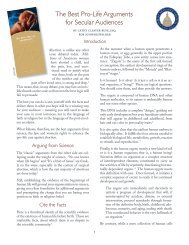The Effects of Divorce on Children - Family Research Council
The Effects of Divorce on Children - Family Research Council
The Effects of Divorce on Children - Family Research Council
You also want an ePaper? Increase the reach of your titles
YUMPU automatically turns print PDFs into web optimized ePapers that Google loves.
performance in math. 197 Teenagers who experience parental divorce score lower<br />
than their counterparts from intact families <strong>on</strong> math, science, and history tests. 198<br />
Some studies show that the correlati<strong>on</strong> between adolescent family disrupti<strong>on</strong> and<br />
educati<strong>on</strong>al attainment is weaker after c<strong>on</strong>trolling for the family’s socioec<strong>on</strong>omic<br />
status. This finding likely reflects the influence <str<strong>on</strong>g>of</str<strong>on</strong>g> income <strong>on</strong> each. 199 One <str<strong>on</strong>g>of</str<strong>on</strong>g><br />
divorce’s attendant problems is the financial instability it inflicts <strong>on</strong> those who<br />
experience it. 200<br />
Lack <str<strong>on</strong>g>of</str<strong>on</strong>g> family transiti<strong>on</strong>s after divorce does not eliminate the effect <str<strong>on</strong>g>of</str<strong>on</strong>g> the<br />
divorce <strong>on</strong> student academic performance, but it does provide their performance<br />
in math and social studies a certain degree <str<strong>on</strong>g>of</str<strong>on</strong>g> protecti<strong>on</strong>, compared to students<br />
who live in unstable families with multiple family transiti<strong>on</strong>s. 201<br />
Age at <str<strong>on</strong>g>Divorce</str<strong>on</strong>g>. Norwegian research found that children who experience<br />
divorce early in life are likely to have lower educati<strong>on</strong>al outcomes, finding that<br />
the effect <str<strong>on</strong>g>of</str<strong>on</strong>g> divorce <strong>on</strong> educati<strong>on</strong> is str<strong>on</strong>gest when the child is young. 202 An<br />
American study, by c<strong>on</strong>trast, found that those who had experienced a late<br />
divorce (between grades six and 10) were more likely to get low grades than<br />
children who experienced an early divorce (between kindergarten and grade<br />
five). 203<br />
C<strong>on</strong>sequences <str<strong>on</strong>g>of</str<strong>on</strong>g> Moving. Residential mobility accounts for 29 percent <str<strong>on</strong>g>of</str<strong>on</strong>g> the<br />
academic performance gap between children living in stepfamilies and children<br />
living with both biological parents. 204 Moving tends to increase behavioral,<br />
emoti<strong>on</strong>al, and academic problems for adolescents. 205<br />
197<br />
Goldstein (1982). As cited in David Popenoe, Life without Father (New York, NY: <str<strong>on</strong>g>The</str<strong>on</strong>g> Free<br />
Press, 1996), 148.<br />
198<br />
Anna Sanz-de-Galdeano and Daniela Vuri, “Parental <str<strong>on</strong>g>Divorce</str<strong>on</strong>g> and Students' Performance:<br />
Evidence from L<strong>on</strong>gitudinal Data,” Oxford Bulletin <str<strong>on</strong>g>of</str<strong>on</strong>g> Ec<strong>on</strong>omics and Statistics 69, no. 3<br />
(2007): 327.<br />
199<br />
Patrick Fagan, “Marriage and Ec<strong>on</strong>omic Well-Being: <str<strong>on</strong>g>The</str<strong>on</strong>g> Ec<strong>on</strong>omy <str<strong>on</strong>g>of</str<strong>on</strong>g> the <strong>Family</strong> Rises or<br />
Falls with Marriage” (Washingt<strong>on</strong>, D.C.: Marriage and Religi<strong>on</strong> <strong>Research</strong> Institute, 2011).<br />
Available at http://downloads.frc.org/EF/EF11E70.pdf.<br />
200<br />
See secti<strong>on</strong> titled “Effect <strong>on</strong> the Marketplace: Financial Struggle.”<br />
201<br />
Y<strong>on</strong>gmin Sun and Yuanzhang Li, “Postdivorce <strong>Family</strong> Stability and Changes in Adolescents'<br />
Academic Performance: A Growth-Curve Model,” Journal <str<strong>on</strong>g>of</str<strong>on</strong>g> <strong>Family</strong> Issues 30, no. 11 (2009):<br />
1546-1547.<br />
202<br />
Fi<strong>on</strong>a Steele, Wendy Sigle-Rusht<strong>on</strong>, and Øystein Kravdal, “C<strong>on</strong>sequences <str<strong>on</strong>g>of</str<strong>on</strong>g> <strong>Family</strong> Disrupti<strong>on</strong><br />
<strong>on</strong> <strong>Children</strong>'s Educati<strong>on</strong>al Outcomes in Norway,” Demography 46, no. 3 (2009): 565.<br />
203<br />
Jennifer E. Lansford, “Trajectories <str<strong>on</strong>g>of</str<strong>on</strong>g> Internalizing, Externalizing, and Grades for <strong>Children</strong><br />
Who Have and Have Not Experienced their Parents' <str<strong>on</strong>g>Divorce</str<strong>on</strong>g> or Separati<strong>on</strong>,” Journal <str<strong>on</strong>g>of</str<strong>on</strong>g> <strong>Family</strong><br />
Psychology 20, no. 2 (2006): 296.<br />
204<br />
Nan Marie Ast<strong>on</strong>e and Sara S. McLanahan, “<strong>Family</strong> Structure, Residential Mobility, and<br />
School Dropout: A <strong>Research</strong> Note,” Demography 31 (1994): 582.<br />
205<br />
John P. H<str<strong>on</strong>g>of</str<strong>on</strong>g>fman and Robert A. Johns<strong>on</strong>, “A Nati<strong>on</strong>al Portrait <str<strong>on</strong>g>of</str<strong>on</strong>g> <strong>Family</strong> Structure and<br />
Adolescent Drug Use,” Journal <str<strong>on</strong>g>of</str<strong>on</strong>g> Marriage and <strong>Family</strong> 60 (1998): 635.<br />
29




